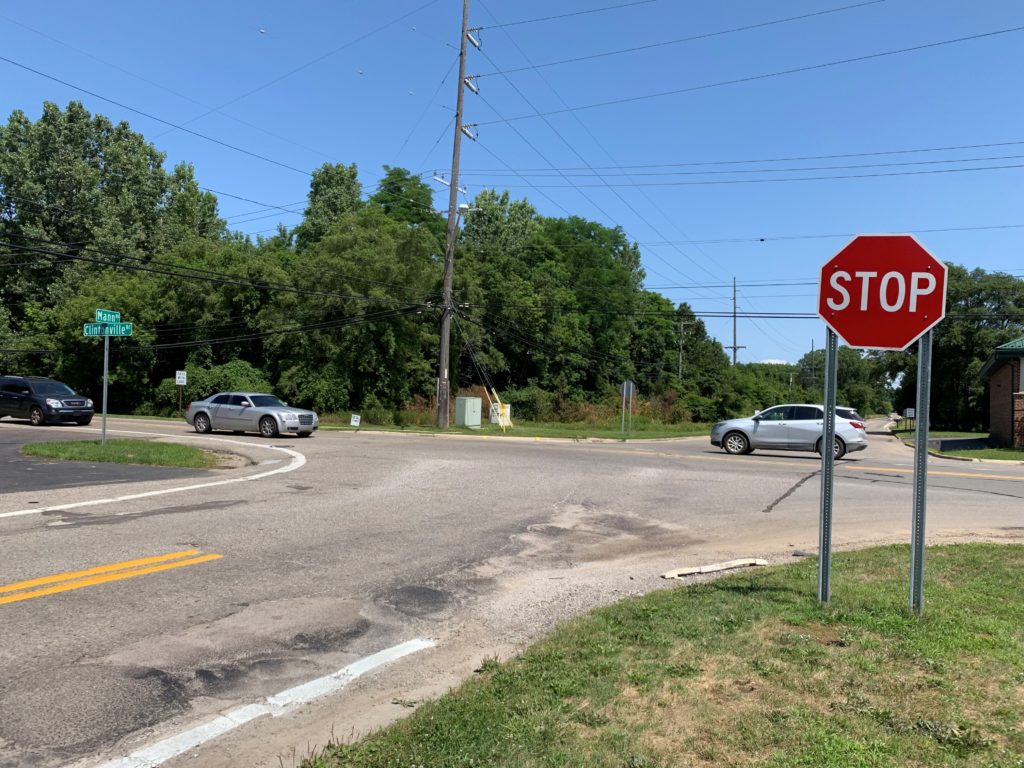
BY MATT MACKINDER
Clarkston News Staff Writer
After a July 30 traffic accident at the intersection of Clintonville and Mann roads where three cars were involved, an area resident voiced his displeasure in an email to The Clarkston News.
“The driver who blew the stop sign on Mann Road east of Clintonville Road took off and was quickly apprehended,” said Michael Powell. “The reason I bring this up? I’ve contacted the RCOC numerous times about the need for a four-way stop at this intersection. Each time it’s been denied. As you know, your paper reported the death that occurred at the very same intersection under the same circumstances a few years back. The driver didn’t see the stop sign and blew through it, killing the passenger in their car.
“When this occurred, I once again contacted the RCOC, and they brought up the old traffic study when they called back and denied my request out of hand. But, interestingly, this spring, I witnessed the RCOC placing a stop sign warning sign on westbound Mann Road heading east to Clintonville Road. Huh? I thought this was odd considering that in my 36 years of living here, the stop sign on Mann Road west of Clintonville Road has never been a problem. It was laughable that the RCOC placed the sign on the side that no one has ever blew through, yet a warning sign has never been placed on Mann Road east of Clintonville Road where the problem is, yet a warning sign has never been placed there. Why?”
Craig Bryson, senior manager of communications and public information for the Road Commission for Oakland County, responded to Powell’s comments.
“Please keep in mind, though, that just because an accident occurred does not mean there is a problem with the road or traffic-control devices,” Bryson said. “Many times, the cause can be attributed to driver error. Lately, we are seeing a lot more distracted-driver crashes, which would not be corrected by a change in the traffic-control device.”
Bryson added that the safety of those using the road system under the RCOC’s jurisdiction is their top priority.
“We spend more time and resources than probably any other local road agency in the state studying and pursuing safety with the goal of reducing serious injury crashes and fatalities in the county,” said Bryson. “It is as a result of this policy and our practices over many decades that Oakland County today has the lowest or second-lowest (it varies slightly year to year) traffic fatality rate of any county in the state and one of the lowest for a county our size and population in the nation. That is not a coincidence.”
Bryson added that there are actually warning sides for both eastbound and westbound Mann Road leading to the stop signs.
“Additionally, late last year, we commissioned a detailed study of several intersections, including this one (Clintonville and Mann), by one of our consulting engineering firms,” Bryson said. “Though the final study has not been completed, the preliminary review has been done. The purpose of the study was to identify and summarize crash patterns at the intersection and determine if changes are needed and warranted. This involved an extensive analysis of crash data, traffic patterns and all other factors related to the current configuration of the intersection.
“The study concluded that a four-way stop at the intersection would not meet warrants (requirements) and, therefore, is not being considered. It is also believed that a four-way stop would not have prevented the serious crashes that have occurred at the intersection, as they involved motorists failing to stop at the existing stop signs.”
As for alternative measures for the intersection, a roundabout is being pursued, according to Bryson, but that is being looked at tentatively for 2025 with funding, acquiring the necessary right of way and the design process taking years to sort out.
“We strongly share Mr. Powell’s desire to make every intersection as safe as possible,” Bryson said. “However, making changes to the intersection that do not actually address the problem and could potentially cause other problems, just so that we can say we did something, is not a solution. Rather, we are a data-driven agency, and we prefer to take deliberative actions that are supported by the data and sound, time-proven engineering concepts.”
